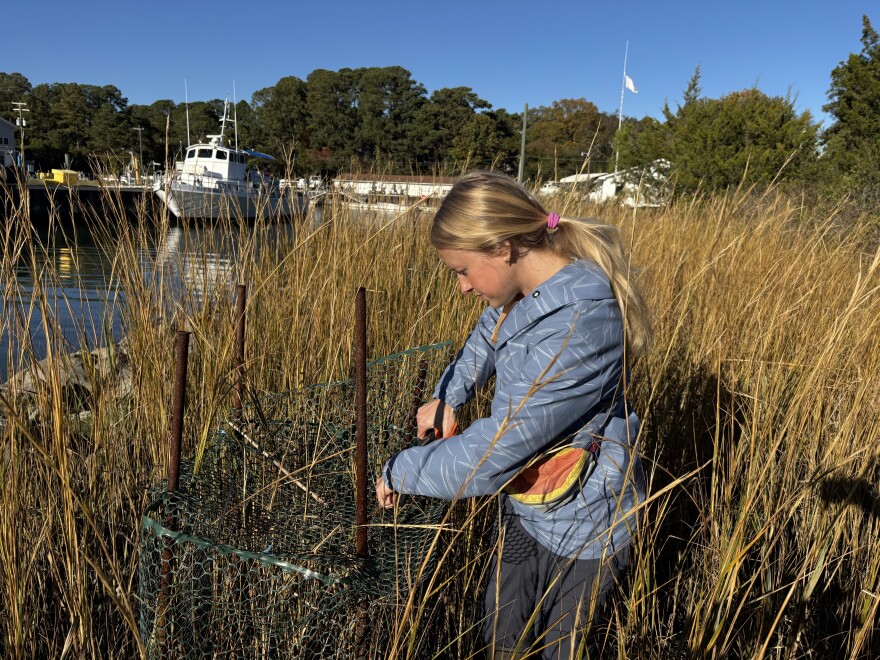Inside the Virginia Institute of Marine Science’s Acuff Center for Aquaculture, beneath a steady flow of water, tens of thousands of baby mussels sat in a tank on a recent afternoon.
Facility manager Lauren Gregg picked up a bucket filled with the tiny creatures, which looked like large grains of wild rice.
“These guys, the larvae just crawl around, we've found, for four to six weeks until you can really start to see their growth take off,” Gregg said.
These bivalves are among the first ribbed mussels spawned at VIMS through a project launched last year. The goal is to place mussels on local shorelines to help fight pollution and erosion.
The William & Mary institute at Gloucester Point has long bred shellfish. The revamped, 20,000-square-foot Acuff Center hatchery along the York River was completed in 2022.
But oysters have been the main focus. Gregg said they’re excited to expand work with more species, including soft-shell clams and bay scallops.

Enter the ribbed mussel. It’s not what you’re used to seeing on your dinner plate.
Those smoother, restaurant types are usually blue mussels, often found on rocks and pilings, said doctoral student Ashley Rose, who’s leading the mussel project for her dissertation at the Batten School & VIMS.
Ribbed mussels have a different niche in the ecosystem, preferring to burrow into mud. That makes them a good candidate for boosting marshland, Rose said.
The project began with a mystery: the case of the missing mussel.
Local scientists have been working for decades to build living shorelines, using materials such as marsh grasses, oyster reefs and rocks to mimic a natural ecosystem and protect land from erosion.
Mussels can be a valuable addition. They clean the water and help bind marsh grasses to sediment. Even their poop helps build up marsh elevation, all of which could help preserve land as sea levels rise, Rose said.
“Unfortunately, we have been finding that ribbed mussels are absent or in very low numbers in these living shoreline marshes,” she said. “So, although we still haven't pinpointed exactly why, we assume that if we can get mussels into living shorelines, it will accelerate the development.”
It takes a lot of time and money to construct a living shoreline, she said. By expanding the natural features involved, such as ribbed mussels, they hope to make those investments last longer.
The team began by spawning ribbed mussels at the Acuff Center using adult specimens collected from a marsh in nearby Guinea.

Millions of larvae are kept in tanks with water piped in from the river right outside and fed algae home-brewed in a vat next door.
Many naturally die off as they grow, but VIMS still ends up with a “huge amount of seed,” or juvenile mussels, Gregg said.
Acuff Center employees found baby bivalves all over the place. They seemed to “go sailing” along the water flowing out of their tanks and end up in drains along the floor.
In August, Rose placed 7,200 ribbed mussels in living shorelines at a handful of test sites — one in Mobjack Bay and two along the York River, including Machicomoco State Park.
When she checked a month later, the outcome was bleak.
“I didn’t find any survivors, which is very sad,” she said. “But I haven’t given up.”
Rose believes the mussels were likely eaten by predators. With her next attempt, she plans to surround the mussels with a finer-mesh netting to keep out crabs and other hungry critters.
And she has further cause for hope.

On an afternoon earlier this month, Rose and some colleagues left the Acuff Center and walked over to a teaching marsh at the edge of campus, bags full of mussels in tow.
Though not an official test site, Rose had strewn some mussels there last year. Now she was there to restock.
She cut open a small mesh enclosure, but before she could toss in the new mussels, she spotted some of the initial round sticking deep into the mud.
“It has to be them. I’m fairly certain. They survived!” Rose called out to her colleagues. “I’m so happy.”



